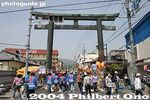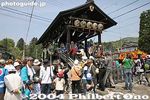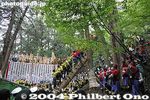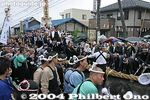 Image search results - "sato" Image search results - "sato" |

Yoshino Baigo was a valley and hillside covered with ume plum trees. It boasted a wide variety of different plum blossoms. During full bloom as you can see here, the scenery was spectacular. One of the largest plum groves in Japan.Platform of Hinata-Wada Station with welcome banner 日向和田駅. Banner says, "Yokoso, Ume no Sato Yoshino Baigo." Yokoso means "welcome," and Ume no Sato means "plum town."
To get to Hinata-Wada, you have to change trains at Ome Station on the JR Chuo Line.
|
|

Closest train station is Hinata-Wada Station. To get to Hinata-Wada, you have to change trains at Ome Station on the JR Chuo Line. 日向和田駅Sadly, spring 2014 was the last time we could see these trees. The plum trees were infected by the plum pox virus and the city cut down all the trees in 2014 to wipe it out. These photos were taken in 2006 when the plums were still fully glorious. Good news is that they have been replanting since 2016.
|
|

Although still small, the replanted plum trees have been flowering. and the groves have reopened to the public. Yoshino Baigo poster. Yoshino Baigo is a small town in Ome city near Hinata-Wada Station.
|
|

Road to Yoshino Baigo. Almost the entire town is lined with plum trees.
|
|

Tamagawa River as seen from the bridge.
|
|

Plum trees line the streets
|
|

Yoshino Baigo's main attraction is the Ume no Koen plum park. This is an entrance leading to the park.
|
|

Ume no Koen park straight ahead, you can see the hill covered with white.
|
|

Entrance to a temple with a view
|
|

Shimosuwa Station on May 8, 2004. Here for the final three days of the Onbashira Matsuri's climax, the Satobiki when they haul the Onbashira logs to the Shimo-sha Shrines (Akimiya and Harumiya) and erect them.
|
|

Marker and side road to Lord Gamo (Gamoh) Ujisato's gravesite. Near Aizu-Wakamatsu City Hall. Gamo Ujisato (1556-1595) was a feudal lord from Hino, Shiga Pref. He built Tsurugajo Castle and named the town Wakamatsu, after a place in his hometown.
|
|

Ohmi Railways Toyosato Station. MAP
|
|

Itoh Chube'e Memorial House (Itoh Chube'e Ki'nenkan). Itoh Chube'e (1842-1903) was the founder of Itochu Corporation and Marubeni, two of Japan's largest trading companies, in 1858. MAPThis house displays his former residence and some of his possessions. A short walk from Toyosato Station, the house is open to the public on Tue., Thu., and Sat. Free admission.
|
|

Great view from temple (no admission charge). Sadly, this is no more...
|
|

Onbashira monument in front of Shimosuwa Station. This Onbashira log was used in the opening ceremony of the Nagano Winter Olympics in 1998.
|
|

Ujisato was married to Oda Nobunaga's second daughter Fuyuhime. He died at age 40. One theory says that he was poisoned by Toyotomi Hideyoshi. Entrance to Lord Gamo Ujisato's gravesite within Kotokuji temple in Aizu-Wakamatsu, Fukushima..
|
|

Entrance to Itoh Chube'e Memorial House
|
|

Inside Toyosato Station.
|
|

View from temple. The plum pox virus was discovered in 2009. Since then, they have cut down the infected and surrounding trees.
|
|

Entertainment stage in front of Shimosuwa Station.
|
|

Entrance doors to Lord Gamo Ujisato's gravesite within Kotokuji temple which is a Zen temple of the Rinzai Sect.
|
|

Entrance to Itoh Chube'e Memorial House
|
|
|
|

In front of Shimosuwa Station.
|
|

Family crest on door. (Not the Gamo crest.)
|
|

Front garden
|
|
|

About 120 varieties of plum blossoms are planted, attracting 60,000 to 100,000 visitors during the flowering season.
|
|
|

Parade of Nagamochi which are long chests. 長持
|
|

Grounds of Lord Gamo Ujisato's gravesite within Kotokuji temple. Since Ujisato was a Christian lord, it is ironic that he be buried in a Buddhist temple in Kyoto and Aizu-Wakamatsu.
|
|

Front garden
|
|

Near the entrance to Ume no Koen plum blossom park that opened in March 1972.
|
|
|
|
|
|

Maid's room
|
|

Ume no Koen (Plum Park) is a public park open from 9 am to 5 pm.
|
|
|

Poem monument reads 限りあれば吹かねど花は散るものを心短き春の山風
|
|

Inside entrance. The house was occupied by Itochu company founder Itoh Chube'e and his son, Chube'e II.
|
|

Toyosato Station platform.
|
|

200 yen admission charged during March only. But I went on April 1 so it was free (and full bloom).
|
|
|
|

Path to Lord Gamo Ujisato's gravesite
|
|
|

Shopkeeper's desk
|
|

White weeping plum blossoms
|
|
|

Lord Gamo Ujisato's grave.
|
|

Shopkeeper's desk
|
|

Red weeping plum blossoms at park entrance
|
|
|

Lord Gamo Ujisato's grave. This is a secondary grave, where his hair is buried. His main grave is at a temple in Kyoto where he died at age 40.
|
|

Shopkeeper's desk
|
|

Red weeping plum blossoms
|
|

Crowded street
|
|
|

Butsudan Buddhist altar in a butsuma (Buddhist altar room).
|
|

Red weeping plum blossoms
|
|
|

The tombstone has five segments each with a kanji character. 五輪塔
|
|

Tokonoma alcove and scroll. 奥の間
|
|

Pink and white weeping plum blossoms
|
|
|

Explanation of the kanji characters on the tombstone. From top to bottom, the characters are for "Sky, wind, fire, water, and earth."
|
|

In 1998, the house was donated to a local foundation. In 2002, the house was opened to the public.
|
|

White weeping plum blossoms
|
|
|

Portrait of Lord Gamo Ujisato
|
|

Exhibits of Itoh Chube'e II, the son of the founder Chube'e (1842-1903).
|
|

Pink weeping plum blossoms
|
|

Nagamochi chest decorations
|
|
|

Bust of Itoh Chube'e II (1886-1973), his walking sticks, bag, and shoes.
|
|

With about 1,300 plum trees, this park is probably Tokyo's largest plum tree grove.
|
|
|

Kotokuji temple
|
|

Kitchen
|
|

Work of art by nature
|
|

Umbrella dance
|
|
|

Path in plum park
|
|
|
|

Kitchen
|
|
|

Shimo-sha Akimiya Shrine torii
|
|

Stove 炊事場
|
|

Path on hillside of plum trees
|
|

Shimo-sha Akimiya Shrine. That's a support pole for erecting the No. 1 Akimiya Onbashira log. 秋宮
|
|

Western-style bath from the early 20th century. Very unusual at the time. 西洋風バスルーム
|
|

Hillside plum trees
|
|

Shimo-sha Akimiya Shrine 秋宮 幣拝殿
|
|

Bathroom sink
|
|

White plum blossoms
|
|

Hole for the No. 4 Akimiya Onbashira log
|
|

Built in 1935, a memorial for Itoh Chube'e in Kurenai Park. くれない園
|
|

The park has about 120 varieties of plum blossoms. You can see how different they look.
|
|

Small support poles.
|
|
|
|
|

Memorial marking Itoh Chobe'e's house, right near Itoh Chube'e's house. Chobe'e was Chube'e's older brother and co-founder of Marubeni Corporation.
|
|

The fragrance is also different. I smelled most of them, and well on my way to becoming a connoisseur of plum blossom fragrances.
|
|

Hole for the No. 2 Akimiya Onbashira log
|
|

Perhaps the most common species of plum blossom.
|
|

Hole for the No. 2 Akimiya Onbashira log
|
|
|

Hole for the No. 2 Akimiya Onbashira log
|
|

Photogenic pink plum tree
|
|
|

Photogenic pink plum tree
|
|

Shimo-sha Akimiya Shrine priests 秋宮
|
|

Rare plum tree with both pink and white blossoms. It has one branch with pink flowers. Never saw that before.
|
|

Taiko performance at Shimo-sha Akimiya Shrine's Kaguraden
|
|
|

Shimenawa sacred rope on Kaguraden
|
|
|

Onbashira Grand Park
|
|

These red ones also smell very nice. Different from the white ones.
|
|

Harumiya torii 春宮大門
|
|
|

On the way to Harumiya Shrine, you see this bridge. It is a rest stop for the Akimiya Onbashira log procession. 下馬橋
|
|
|

The bridge is normally closed to the public. In the old days, this bridge marked Harumiya Shrine's sacred area where even warlords had to get out of their palanquin or get off their horse out of respect before proceeding further. 下馬橋
|
|
|

Harumiya Shrine ahead.
|
|

View from one observation rest house
|
|

Harumiya Shrine torii 春宮
|
|
|

Harumiya has a little slope where the logs are slid down.
|
|
|

People everywhere.
|
|
|

People along the small slope.
|
|
|

This is May 9, 2004, the second day of Shimo-sha Shrine's Satobiki. Shimo-sha Shrine consists of two separate shrines called Akimiya and Harumiya.
|
|

Path going further up the hill
|
|

Ropes to pull the Onbashira log from Harumiya Shrine.
|
|
|

Log in Harumiya Shrine.
|
|

Needless to say, the entire place was filled with sweet fragrance.
|
|

Onbashira Log No. 1 already erected for Harumiya Shrine on May 8, 2004.
|
|
|

Erecting Onbashira Log No. 4 for Harumiya Shrine on May 9, 2004. 春宮四之御柱
|
|

Spectacular view
|
|

Erecting Onbashira Log No. 4 for Harumiya Shrine on May 9, 2004. Shimosuwa, Nagano. 春宮四之御柱
|
|
|

Everything is done with great fanfare, with these men riding on the log as it slowly rises by a system of cables and pulleys.
|
|
|

"Yoisa! Yoisa!"
|
|

Path going further up the hill
|
|
|
|

Rest house at top of the hill
|
|
|

View from top
|
|
|
|

Weeping plum blossoms at the top of the plum tree "waterfall."
|
|

When the log is erected, a banner is unrolled.
|
|

A "waterfall" of weeping plum blossoms しだれ梅の滝
|
|

The banner reads, "Thank you everyone for your cooperation."
|
|

Weeping plum trees part of the "waterfall"
|
|
|

A "waterfall" of weeping plum blossoms (Shidare ume no taki) しだれ梅の滝
|
|
|
|

Yoshino Baigo plum trees
|
|

Sake is given for free.
|
|

Spectacular viewpoint
|
|
|
|
|
|
|

The men now descend from the log.
|
|

Wish the sweet fragrance could come through your computer screen...
|
|
|

The park is 35,000 sq. meters.
|
|

Onbashira Log No. 3 for Harumiya Shrine.
|
|
|

The base of the Onbashira log is reinforced by these smaller logs.
|
|

Notice the plum blossom "waterfall" on the left.
|
|

Music Box Museum
|
|

Minabe in Wakayama Pref. is the only place where I saw more plum blossoms than this.
|
|

Parade
|
|
|

One Onbashira log at a rest stop.
|
|
|

Ropes at rest
|
|

This one is nicknamed "Married couple" blossom because it looks like two flowers have fused as one.
|
|

The logs are pulled by people from various districts or parishes in the Suwa region including Chino, Shimosuwa, Okaya, and Suwa.
|
|
|

Another Onbashira log makes its way through.
|
|

I think the white ones smell the sweetest...
|
|

All the Onbashira logs are hauled manually by human hands from when it is cut in the mountain forest. No motor vehicles of any kind is used to haul the logs.
|
|
|
|
|
|
|
|

The log can move quite fast, even with all those people riding it.
|
|
|
|
|

Cherry blossom-type plum blossom called "sakura-bai." 桜梅
|
|
|

Closeup of "sakura-bai." Very beautiful. 桜梅
|
|

This looks like Log No. 2 for Akimiya Shrine.
|
|

The reds and whites contrast well with the dark greens...
|
|

These people are from Suwa city.
|
|
|

Ax man
|
|

Rest house
|
|
|

Marker commemorating a "Plum Summit" held in Ome by representatives of cities well-known for plum blossom gardens, such as Mito, Ibaraki; Atami, Kanagawa; and Annaka, Gunma.
|
|

Log standing by in front of Akimiya Shrine.
|
|
|

Onbashira-sai, Shimosuwa-machi, Nagano.
|
|

Another tree with photogenic blossoms
|
|

Log standing by in front of Akimiya Shrine.
|
|

Photogenic blossoms
|
|
|
|

Parade continues even in the rain.
|
|
|
|
|
|
|

Fluffy blossoms
|
|
|
|
|
|
|

Now it's May 10, 2004, the last day of the Shimo-sha Satobiki. All four logs will erected at Akimiya Shrine on this day.
|
|
|

We waited in the rain for Onbashira Log No. 1 to be erected first at Akimiya Shrine at 10:00 am. However, we had to wait, standing up in the rain and in the crowd, for 2.5 hours before they finally started to raise the log.
|
|
|

Finally, something to photograph.
|
|
|
|
|
|

They threw out free streamers and I caught one. "Yoisa! Yoisa!"
|
|

There's a Web site that shows the condition of the blooming blossoms every day during March. So you know when to go.
|
|
|
|

The question is, where are the plums (fruit)? You see only flowers.
|
|
|
|

They waved their pom-poms and cheered all the while.
|
|

Taiko-bashi Bridge
|
|
|
|

Onbashira Festival. They included one woman.
|
|

I sure had my fill of plum blossoms this year...
|
|

Banners unfurled.
|
|

Path to exit
|
|
|
|